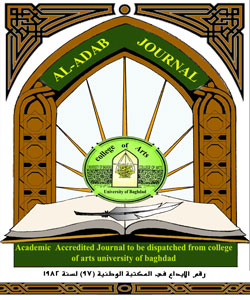Developing the Writing Skill of the University of Technology' Students by using Clustering Technique
DOI:
https://doi.org/10.31973/aj.v1i131.718Keywords:
clustering, technique, writing, studentsAbstract
The difficulties in writing are considered one of the most significant problems that have an effect on non-native English speakers. This study aims at developing the writing skills by using clustering technique to the University of Technology' students, then making a comparison between students' performance in writing in a per and post-test. A pre-test was made to the students to know their level in writing an essay then a course of study in teaching writing by using clustering technique was delivered to the students then a post-test is taken by students. The study aims at showing the influence using clustering technique in students' performance in writing. So the results have shown that there is a great development in students’ performance in writing after their involvement in the course
Downloads
References
Alice Oshima, (1981), Writing Academic English, New York: Addison-Wesley, p.9
Barbara Fine Clouse, (2005), A Trouble shooting Guides Strategies & Process for Writers, New York: McGraw Hill, 4th Edition, p. 24-26)
Bell, R. T. (1991) Translation and Translating: Theory and Practice. London: Longman
Brown, H. D. (2004). Language assessment: principles and classroom practices. New York: Pearson Education.
Ellis, R. (2003). Task-based language learning and teaching. Oxford: Oxford University Press.
Frans M. Royan, (2004), Cluster Strategy, Jakarta: PT Gramedia Pustaka Utama, p. 82
Grabowski, J. (1996). Writing and speaking: Common ground and differences toward a regulation theory of written language production. In C. M. Levy & S. Ransdell (Eds.), The science of writing (pp. 1-27). New Jersey: Lawrence Erlbaum Associates.
H. Manser, (1995), Oxford Learners Pocket Dictionary, Hong Kong: Oxford University Press, p.190
Hamp-Lyons, L., & Kroll, B. (1997). TOEFL 2000 – writing: Composition, community, and assessment. New Jersey: Educational Testing Service.
Hoey, M. (1991) Patterns of Lexis in Text. Oxford: Oxford University Press
http://dx.doi.org/10.1017/CBO9780511732997
Hughes, A. (2003) Testing for Language Teachers, 2nd edition. Cambridge: Cambridge University Press
Jack C. Richard and Theodore S. Rodgers, (1986), Approach and Language Teaching, New York: Cambridge University Press, p. 15
Kroll, B. (1990). Considerations for Teaching an ESL/EFL Writing Course. In Celce-Murcia, M. (Ed.). (2001). Teaching English as a second or foreign language (3rd ed., pp. 219-232). New York: Heinle & Heinle.
McCroarty, M. (1996). Language attitudes, motivation, and standards: Sociolinguistics and language teaching. New York: Cambridge University Press
Mukulu, E., Indangasi, H., Mwangi, P., Gecaga, C. &Okanga, N. (2006.) KCSE revision English. Nairobi.Kenya Literature Bureau.
Myles, J. (2002). Second language writing and research: The writing process and error analysis in student texts. Teaching English as a second or foreign language Jour-nal, 6(2),1-19.
Negari, G.M. (2011). A study on strategy instruction EFL learners’ writing. International journal of English linguistics. Vol. 1 (2), 299-307.
Ouma, N. (2005). “Relationship between achievement motivation and performance in English composition among secondary school students in Nyando district, Ken-ya”. Unpublished masters thesis. Kenyatta University.
Rao.Z. (2007). Training in brainstorming and developing writing skills. ETL Journal, 61(2), 44-51.
Reppen, R. (2002). The genre-based approach to content writing instruction. In J. C. Richards & W. A. Renandya (Eds.), Methodology in language teaching: An anthology of current practice (pp. 321-327). Cambridge: Cambridge University Press. http://dx.doi.org/10.1017/CBO9780511667190.045.
Weigle, S. C. (2002). Assessing writing. Cambridge: Cambridge University Press.
Weir, C. J. (1990) Communicative Language Testing. New York: Prentice Hall.
Yule, G. (1996) The Study of Language, second edition. Cambridge: Cambridge University Press.View publication
Downloads
Published
Issue
Section
License
Copyright and Licensing:
For all articles published in Al-Adab journal, copyright is retained by the authors. Articles are licensed under an open access Creative Commons CC BY 4.0 license, meaning that anyone may download and read the paper for free. In addition, the article may be reused and quoted provided that the original published version is cited. These conditions allow for maximum use and exposure of the work.
Reproducing Published Material from other Publishers: It is absolutely essential that authors obtain permission to reproduce any published material (figures, schemes, tables or any extract of a text) which does not fall into the public domain, or for which they do not hold the copyright. Permission should be requested by the authors from the copyrightholder (usually the Publisher, please refer to the imprint of the individual publications to identify the copyrightholder).
Permission is required for: Your own works published by other Publishers and for which you did not retain copyright.
Substantial extracts from anyones' works or a series of works.
Use of Tables, Graphs, Charts, Schemes and Artworks if they are unaltered or slightly modified.
Photographs for which you do not hold copyright.
Permission is not required for: Reconstruction of your own table with data already published elsewhere. Please notice that in this case you must cite the source of the data in the form of either "Data from..." or "Adapted from...".
Reasonably short quotes are considered fair use and therefore do not require permission.
Graphs, Charts, Schemes and Artworks that are completely redrawn by the authors and significantly changed beyond recognition do not require permission.
Obtaining Permission
In order to avoid unnecessary delays in the publication process, you should start obtaining permissions as early as possible. If in any doubt about the copyright, apply for permission. Al-Adab Journal cannot publish material from other publications without permission.
The copyright holder may give you instructions on the form of acknowledgement to be followed; otherwise follow the style: "Reproduced with permission from [author], [book/journal title]; published by [publisher], [year].' at the end of the caption of the Table, Figure or Scheme.












